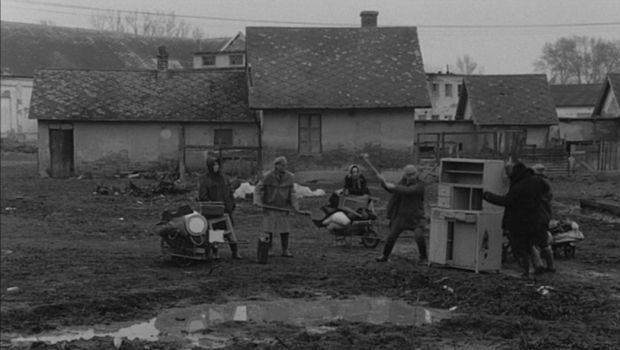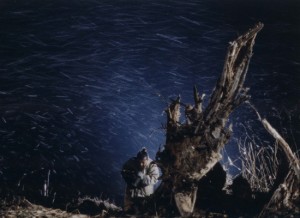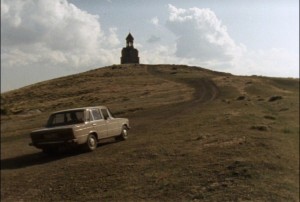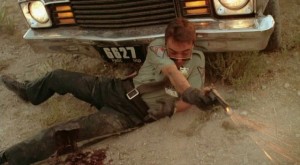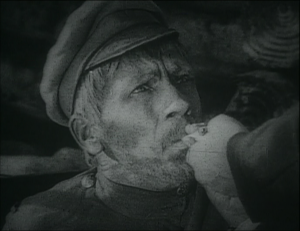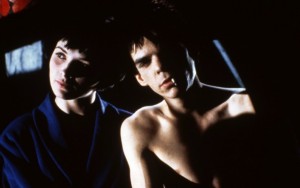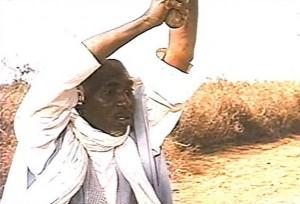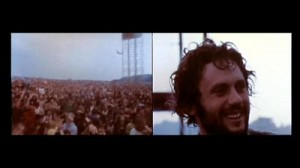From the Chicago Reader (January 6, 1995).
Many friends and colleagues have been moaning about what a bad year 1994 was for movies, but I disagree. The main issue, I think, isn’t so much how we feel about the same movies — though there are a few differences there, including in some cases where and when we happened to see them — as it is what we saw. If you’re lucky enough to be living in Chicago, you had loads of terrific movies to see last year, new as well as old, and if you didn’t see very many of them, it’s possible that you were looking in the wrong places — where the mass media was telling you to look. Because of their running times, my two favorite films, the seven-hour Satantango and the nearly 26-hour The Second Heimat, received only limited exposure, yet I refuse to accept the standard alibi of most critics who neglected to see them — that they were too difficult or esoteric for the general public. I found them easier to sit through and vastly more involving and pleasurable than such overhyped and overattended European monoliths as Germinal and Queen Margot, which to the best of my knowledge gave little enjoyment to most people. On the other hand most audiences who got to Satantango and The Second Heimat seemed to find them well worth the trouble. Because both films were shown in segments that lasted no longer than average-length features, the only serious obstacle they posed was the overall time commitment they demanded — a great deal, to be sure, but certainly not so daunting if they had been shown as TV miniseries, or had been made available on video (which is how I first saw both of them). The fact that the publicity machines went to work on snooze fests like Germinal and Queen Margot and not on Satantango or The Second Heimat (neither of which even acquired a U.S. distributor) tells us plenty about the film business, but says nothing about the art of film in the mid-90s. These fabulous but lengthy films had limited exposure because distributors couldn’t find a way to make money off them, not because of their quality. 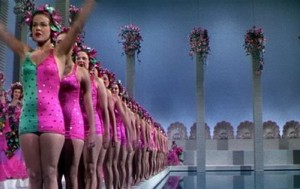 Even when the studios come up with something genuinely unprecedented, like That’s Entertainment! III, they often don’t know what they have or what to do with it. MGM had so little faith in that movie that if it weren’t for the persistent efforts of the Music Box, it wouldn’t have made it to Chicago at all. I’m told that MGM decided that the commercial failure of Midnight Cowboy‘s rerelease somehow “proved” that people didn’t care about seeing old movies — not even never before seen sequences from many of the best musicals ever made — so the movie got unceremoniously dumped. To add insult to injury, they put together a trailer so deceitful that it might well have convinced you to stay away all by itself: clips of Judy Garland singing “Over the Rainbow” and Gene Kelly performing “Singin’ in the Rain” that basically informed you this movie was strictly for dunderheads who hadn’t seen enough of those chestnuts already. A few other items on my list were only around for a screening or two, but most of them had proper runs at commercial theaters; with luck, a couple or more of them may be still playing by the time this reaches print. Two key items that certainly would have qualified, The Blue Kite and Bitter Moon, are missing only because I placed them on last year’s list, by virtue of their appearances at the Chicago International Film Festival. (The latter film, incidentally, proved to have an enormous staying power in Chicago over most of the year, in striking contrast to the cool reception it received a year or so before that in Europe.)
Even when the studios come up with something genuinely unprecedented, like That’s Entertainment! III, they often don’t know what they have or what to do with it. MGM had so little faith in that movie that if it weren’t for the persistent efforts of the Music Box, it wouldn’t have made it to Chicago at all. I’m told that MGM decided that the commercial failure of Midnight Cowboy‘s rerelease somehow “proved” that people didn’t care about seeing old movies — not even never before seen sequences from many of the best musicals ever made — so the movie got unceremoniously dumped. To add insult to injury, they put together a trailer so deceitful that it might well have convinced you to stay away all by itself: clips of Judy Garland singing “Over the Rainbow” and Gene Kelly performing “Singin’ in the Rain” that basically informed you this movie was strictly for dunderheads who hadn’t seen enough of those chestnuts already. A few other items on my list were only around for a screening or two, but most of them had proper runs at commercial theaters; with luck, a couple or more of them may be still playing by the time this reaches print. Two key items that certainly would have qualified, The Blue Kite and Bitter Moon, are missing only because I placed them on last year’s list, by virtue of their appearances at the Chicago International Film Festival. (The latter film, incidentally, proved to have an enormous staying power in Chicago over most of the year, in striking contrast to the cool reception it received a year or so before that in Europe.) 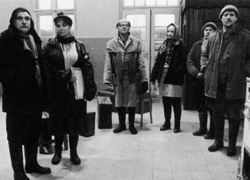 1. Satantango. Bela Tarr’s riveting sarcastic comedy about self-interest and self-deception was the surest sign all year that personal filmmaking is alive and well, at least as long as some personal filmmakers are sufficiently gifted and original — as well as persistent enough to go the limit with their projects. In this case, Tarr spent 120 shooting days in ten separate parts of Hungary over two years to make a movie so concentrated, single-minded, and clear-headed that it puts most of Hollywood to shame. Tarkovsky is one of Tarr’s acknowledged influences, this film’s despiritualized landscapes, its exciting and singular narrative structure, its uncanny capacity to deal cogently with a couple of characters in isolation over long periods, and its gallows humor are worlds apart from the films of the late Russian director. So is its literary source, a 1985 novel by Laszlo Krasznahorkai (who collaborated with Tarr on the script); it still hasn’t been translated, but if it ever is, it’s the first Hungarian novel I’ll want to read. The film played here only once, at the film festival, with Tarr in attendance, and it says something about the involvement of the audience (most of whom stayed the film’s duration) that the subsequent question-and-answer session lasted about an hour.
1. Satantango. Bela Tarr’s riveting sarcastic comedy about self-interest and self-deception was the surest sign all year that personal filmmaking is alive and well, at least as long as some personal filmmakers are sufficiently gifted and original — as well as persistent enough to go the limit with their projects. In this case, Tarr spent 120 shooting days in ten separate parts of Hungary over two years to make a movie so concentrated, single-minded, and clear-headed that it puts most of Hollywood to shame. Tarkovsky is one of Tarr’s acknowledged influences, this film’s despiritualized landscapes, its exciting and singular narrative structure, its uncanny capacity to deal cogently with a couple of characters in isolation over long periods, and its gallows humor are worlds apart from the films of the late Russian director. So is its literary source, a 1985 novel by Laszlo Krasznahorkai (who collaborated with Tarr on the script); it still hasn’t been translated, but if it ever is, it’s the first Hungarian novel I’ll want to read. The film played here only once, at the film festival, with Tarr in attendance, and it says something about the involvement of the audience (most of whom stayed the film’s duration) that the subsequent question-and-answer session lasted about an hour. 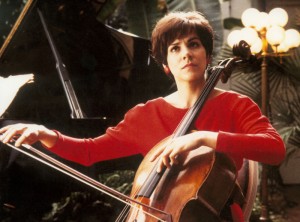 2. The Second Heimat. All 13 features in Edgar Reitz’s 1992 German epic about youth, love, and art in the 60s played twice at the Film Center last spring — once over a four-day marathon and a second time over a succession of Thursdays and Sundays — and to follow it either way meant entering into a mesmerizing narrative contract with Reitz that was almost as involving as reading Proust. Not quite as innovative as Satantango (or “Three Colors” or even That’s Entertainment! III), Reitz’s multifaceted chronicle of a generation summed up the best of 60s filmmaking while offering a thoughtful and searching critique of what that filmmaking — and that generation — accomplished and failed to accomplish. Most of the leading characters are classical musicians and filmmakers, and one central part of the film’s pleasure is the musical performances (the work of Nikos Mamangakis, who composed the score, deserves an essay in its own right). Another is Reitz’s handling of extended party scenes, which grow in resonance as one becomes progressively more acquainted with his large and unforgettable cast of characters. Even the film’s absences and ellipses played a crucial role: I’m still trying to figure out why Reinhard commits suicide and why Renate, unlike the other major figures, isn’t accorded a full feature of her own; both of them remain indelibly lodged in my memory.
2. The Second Heimat. All 13 features in Edgar Reitz’s 1992 German epic about youth, love, and art in the 60s played twice at the Film Center last spring — once over a four-day marathon and a second time over a succession of Thursdays and Sundays — and to follow it either way meant entering into a mesmerizing narrative contract with Reitz that was almost as involving as reading Proust. Not quite as innovative as Satantango (or “Three Colors” or even That’s Entertainment! III), Reitz’s multifaceted chronicle of a generation summed up the best of 60s filmmaking while offering a thoughtful and searching critique of what that filmmaking — and that generation — accomplished and failed to accomplish. Most of the leading characters are classical musicians and filmmakers, and one central part of the film’s pleasure is the musical performances (the work of Nikos Mamangakis, who composed the score, deserves an essay in its own right). Another is Reitz’s handling of extended party scenes, which grow in resonance as one becomes progressively more acquainted with his large and unforgettable cast of characters. Even the film’s absences and ellipses played a crucial role: I’m still trying to figure out why Reinhard commits suicide and why Renate, unlike the other major figures, isn’t accorded a full feature of her own; both of them remain indelibly lodged in my memory. 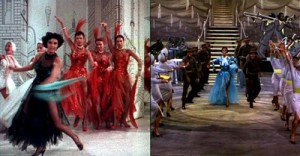 3. That’s Entertainment! III. This is a delight that effectively came out of nowhere. The two MGM compilations of musical clips that preceded it — three if one counts That’s Dancing! — were routine exercises in self-congratulation dosed with hypocritical piety; for this one the studio not only opened its treasure chest of unseen and unused numbers but offered us a bracing and intelligent critique of studio decision making. The two writers-directors-editors-producers, Bud Friedgen and Michael J. Sheridan, worked as editors on the previous films, which must have afforded them ample opportunity to think about how they could improve on the work of their predecessors, even while adhering to the same basic format of having former MGM stars introduce the clips. One improvement was allowing Lena Horne to expound on the racist policies that curtailed her work at the studio; another was the use of editing and split-screen devices to show us separate versions of the same number side by side or back-to-back, explaining in some cases how the wrong version got picked, or in others how the best version got put together. In addition to a few familiar items, one gets to see excluded footage from Singin’ in the Rain, The Band Wagon, Cabin in the Sky, The Harvey Girls, Easter Parade, the otherwise unseeable Annie Get Your Gun, and even a neglected gem like I Love Melvin. You also get to hear a snatch of the heartbreaking rendition of “Can’t Help Lovin’ Dat Man” Ava Gardner recorded for Show Boat, which the studio inexplicably chose to dub with another singer’s voice. A fascinating history lesson, this shares some of the limitations of other such compilations, but the overall sharpness of the selections made it for me the most pleasurable Hollywood release of the year. It’s already out on video, and though it inevitably loses part of its impact on the small screen, most of the original wide-screen ratios have been preserved.
3. That’s Entertainment! III. This is a delight that effectively came out of nowhere. The two MGM compilations of musical clips that preceded it — three if one counts That’s Dancing! — were routine exercises in self-congratulation dosed with hypocritical piety; for this one the studio not only opened its treasure chest of unseen and unused numbers but offered us a bracing and intelligent critique of studio decision making. The two writers-directors-editors-producers, Bud Friedgen and Michael J. Sheridan, worked as editors on the previous films, which must have afforded them ample opportunity to think about how they could improve on the work of their predecessors, even while adhering to the same basic format of having former MGM stars introduce the clips. One improvement was allowing Lena Horne to expound on the racist policies that curtailed her work at the studio; another was the use of editing and split-screen devices to show us separate versions of the same number side by side or back-to-back, explaining in some cases how the wrong version got picked, or in others how the best version got put together. In addition to a few familiar items, one gets to see excluded footage from Singin’ in the Rain, The Band Wagon, Cabin in the Sky, The Harvey Girls, Easter Parade, the otherwise unseeable Annie Get Your Gun, and even a neglected gem like I Love Melvin. You also get to hear a snatch of the heartbreaking rendition of “Can’t Help Lovin’ Dat Man” Ava Gardner recorded for Show Boat, which the studio inexplicably chose to dub with another singer’s voice. A fascinating history lesson, this shares some of the limitations of other such compilations, but the overall sharpness of the selections made it for me the most pleasurable Hollywood release of the year. It’s already out on video, and though it inevitably loses part of its impact on the small screen, most of the original wide-screen ratios have been preserved. 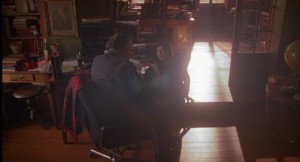 4. Blue, White, and Red (“Three Colors“). I preferred Krzysztof Kieslowski’s Blue to his White and his Red to his Blue when they came out individually. But given the rare achievement of his trilogy as a whole, it would be churlish to include only one or two parts on my list, especially because they work better together than they do separately. Like Pulp Fiction (see below), these films were handled by Miramax, the most sophisticated marketers of independent movies around — as well as the most active in recutting and/ or retitling. Kieslowski’s trilogy and Pulp Fiction are two cases where their interference was minimal; in the case of something like The Advocate, which they both retitled and substantially recut, I refuse to consider eligible for my list — even though I enjoyed it — because I haven’t seen the original.
4. Blue, White, and Red (“Three Colors“). I preferred Krzysztof Kieslowski’s Blue to his White and his Red to his Blue when they came out individually. But given the rare achievement of his trilogy as a whole, it would be churlish to include only one or two parts on my list, especially because they work better together than they do separately. Like Pulp Fiction (see below), these films were handled by Miramax, the most sophisticated marketers of independent movies around — as well as the most active in recutting and/ or retitling. Kieslowski’s trilogy and Pulp Fiction are two cases where their interference was minimal; in the case of something like The Advocate, which they both retitled and substantially recut, I refuse to consider eligible for my list — even though I enjoyed it — because I haven’t seen the original.
5. Fly High Run Far. Ever since I caught this briskly paced and gorgeously filmed period epic a little over three years ago in Taipei, I’ve regarded it as the best Korean movie I know. It looked every bit as impressive as I remembered when it turned up at the Film Center in July. Directed by the most famous, most popular, and probably the most prolific Korean director, Im Kwon-taek, who has made over 80 films, and beautifully shot in seasonal colors, it covers the four decades in the late 19th century when the radically humanist and egalitarian religious sect known as Kae Byok flourished. I found both its pageantry and its leading character — Hae-Wol, the sect’s charismatic leader — deeply moving and its sense of economy exemplary.
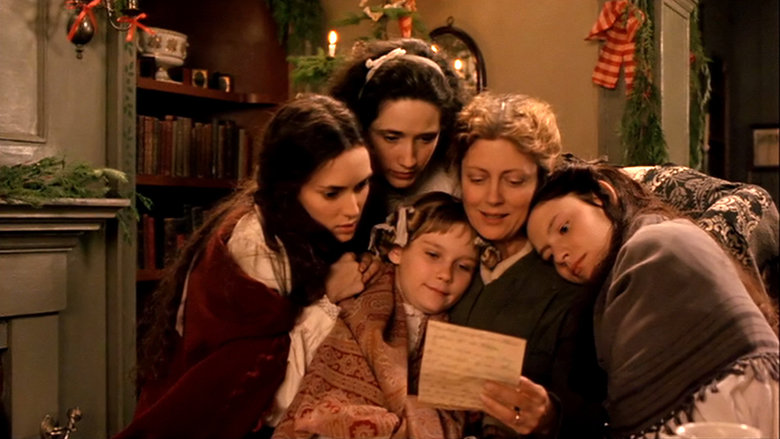
6. Little Women. I’ve never read Lousia May Alcott’s 1869 novel, nor do I recall ever seeing the previous screen adaptations directed by George Cukor (1933), Mervyn LeRoy (1949) or David Lowell Rich (1978, for TV). But unlike almost every other example of mainstream, English-language fiction filmmaking that I saw last year, this film was one I could enjoy and admire without feeling I had to make excuses or apologies. Its impeccable craft (including its wonderful cast) is a virtue I’ve come to expect from the Australian writer-director Gillian Armstrong, but her lovely sense of period tied to a fresh and intelligent grasp of the American past is something a good deal rarer nowadays. (The only other commercial movie that showed this sort of flair was also made by a non-American — Alan Parker’s uneven but underrated The Road to Wellville.) If fans of Pulp Fiction (or The Age of Innocence, for that matter), scoff at Little Women‘s genteel subject matter, that’s only because the sentimentality of girls’ pictures has less prestige at the moment than that of boys’ pictures. (For the sentimentality of men’s pictures, see #8 and #9 and for the sentimentality of a women’s picture, see I Like It Like That, listed under #10.) In any case, this movie, surprisingly tough-minded about its characters and what they want, isn’t fairly labeled as a girls’ movie; it also deserves to be seen by grown-ups.
7. Calendar. Atom Egoyan’s most satisfying movie to date is also the only recent movie I’ve seen about tribalism that deserves to be described as such. Using some of his familiar loop strategies, whereby the same material gets compulsively replayed, Egoyan tells a story about a marriage that disintegrates during a trip from North America to Armenia, where an assimilated Canadian-Armenian photographer (Egoyan himself), while shooting a dozen rural churches for a calendar, becomes insanely jealous when his diasporan Armenian wife (Egoyan’s real-life wife Arsinee Khanjian) converses with their guide in Armenian. The film alternates between this painful situation, captured in video and photographic records, and subsequent scenes back in Toronto,where the husband attempts to converse with various other women in English only to find each of these conversations interrupted by the woman making a telephone call and talking to someone else in a foreign language (with the photographer’s finished calendar hanging in the background). Much of this plays as grim comedy, and if the rigorous formalism of Egoyan’s method strikes some viewers as formulaic and overextended — even at 75 minutes — for me it represented an energizing, illuminating, and challenging breakthrough out of the more insulated concerns of Egoyan’s other recent features. For once he has connected his obsessions about sex and media with the ethnic conflicts raging in the world outside, and the advances this leads to in his work are considerable.
8. Highway Patrolman. What ever happened to the anarchic and resourceful Alex Cox, the English-born, American-trained independent who made Repo Man, Sid & Nancy, and Walker? He moved to Mexico and started a second career with this terrific 1992 Spanish-language portrait of a Mexican highway patrolman (Roberto Sosa) that was far and away the best and most believable cop movie to show in Chicago last year. (Its possible competitor, Charles Burnett’s The Glass Shield, is still being back held from release and may not even surface in its brilliant original form.) Working in a virtuoso long-take style (the whole movie has only 187 cuts), Cox mixes comedy with tragedy and social critique with straight-ahead action. Meanwhile, making the most of Mexican landscapes and a talented cast, this movie refuses to either idolize or demonize its three-dimensional hero, much less the morally complex world he moves through. It took two years for this gem to reach Chicago; let’s hope we won’t have to wait too much longer to see Cox’s masterful baroque, black-and-white adaptation of Jorge Luis Borges’s “Death and the Compass,” made in Mexico for the BBC around the same time.
9. The Last Bolshevik. The only video on my list apart from Godard’s Only Cinema (see below), Chris Marker’s moving personal essay about his late friend and mentor Alexander Medvedkin was in many respects also a guarded self-portrait of Marker himself, trying to bear witness to his own communist dreams and what he, Medvedkin, and history itself made — or didn’t make — of them. It got me interested in the Medyedkins (mainly undocumented) career, and it prompted a good many second thoughts about the leftist idealism of this century, which too many people have been all too eager to sweep under the carpet. A couple of leftist friends complained that Marker’s melancholy ruminations were too self-serving and not really probing enough, but for me they started off chains of thought and investigation that are still going on. I suppose a lot depends on whether you regard this movie as a moratorium or a starting point. For me, it was the latter.
10. Just to prove what a good year for movies the last one was, let me propose a 20-way tie here between Leos Carax’s Bad Blood, Bill Forsyth’s Being Human, Nanni Moretti’s Caro Diario, Wong Kar-wei’s Chungking Express, Tim Burton’s Ed Wood, Rose Troche’s Go Fish, Ousmane Sembene’s Guelwaar, Steve James, Frederick Marx, and Peter Gilbert’s Hoop Dreams, Darnell Martin’s I Like It Like That, Nicolas Philibert’s In the Land of the Deaf, Bigas Luna’s Jamon Jamon, Hai Ninh’s The Little Girl of Hanoi (made and released in Vietnam in 1974, but arriving here 20 years later), David Mamet’s Oleanna, Frank Perry’s On the Bridge (a persuasive and upbeat account of his struggle with cancer), Only Cinema (part three of Jean-Luc Godard’s Histoire(s) du cinema), Quentin Tarantino’s Pulp Fiction, Ken Loach’s Raining Stones, Cyril Collard’s Savage Nights, Tran Anh Hung’s The Scent of Green Papaya, and Peter Bogdanovich’s The Thing Called Love (which didn’t make it to most other American cities, but played here thanks to the efforts of the Music Box). I wouldn’t call any of these movies perfect, but they were all awfully good in one way or another, and they’ve all certainly stayed with me. Some, like Forsyth’s, were scorned in the mainstream media; a few, like Ed Wood, Hoop Dreams, and Pulp Fiction were widely applauded; most were routinely ignored.
And here are 35 perfectly respectable runners-up — again, not an exhaustive list, but enough to prove my point about the quality of this year’s films: Mohsen Makhmalbaf’s The Actor (at the Film Center), John N. Smith’s The Boys of St. Vincent (at Facets Multimedia), Bullets Over Broadway, Clerks, Cobb, Ann Turner’s goofy Dallas Doll (at the festival), Godard’s Deadly Beauty (part four of Histoire(s) du cinema, at the Film Center), Jacques Rivette’s Divertimento, Claude Chabrol’s The Eye of Vichy (at Facets), Atom Egoyan’s Exotica (at the festival), Dang Nhat Minh’s The Girl on the River (at Facets), Godard’s Helas pour moi, Godard’s JLG/JLG (at the Film Center), Ken Loach’s Ladybird Ladybird (at the festival), Louis Antonelli’s Last Day in Chicago (a one-shot at the Patio), Allison Anders’s Mi Vida Loca, Naked, Adolfo Aristarain’s A Place in the World, Chantal Akerman’s Portrait of a Young Girl from Brussels (at the festival), Robert Redford Quiz Show, Haile Gerima’s Sankofa (which had a respectable run both here and elsewhere after Gerima resourcefully went outside the usual channels and venues and simply rented theaters in order to show it), Michael Haneke’s Seventh Continent (at the festival and at Facets), Russell Mulcahy’s The Shadow (especially for its fabulous sets), Frank Darabont’s The Shawshank Redemption, Ake Sandgren’s The Slingshot, Starting Place (Robert Kramer’s affecting documentary about Vietnam today, at the festival), Eric Rohmer’s A Tale of Winter, Abbas Kiarostami’s Through the Olive Trees (at the festival), Tigrero: A Film That Was Never Made (Sam Fuller holding forth about the unmade film to Jim Jarmusch, courtesy of Mika Kaurismaki, at the festival), Marcel Ophuls’s The Troubles We’ve Seen (at the festival), Joseph Ramirez’s Viridian (at the Film Center), Tom Noonan’s What Happened Was…, Sara Driver’s When Pigs Fly (at the festival), Alexander Sokuruv’s Whispering Pages (at the festival), and Andre Techine’s Wild Reeds (at the festival). If you consider that a dozen of these 35 films played at the Chicago International Film Festival, and that 8 more from my earlier lists did as well, there’s a sobering thought here: in order to keep up with the best movies, our local festival — along with the Music Box, the Film Center, and Facets Multimedia — has become absolutely indispensable, much more so, I would say, than any of the major studios or major distributors, who, with vastly greater means at their disposal, finked out on us repeatedly, week after week. It’s been proven by now that they can make more money by washing our brains with dirty water than by improving our lives, so they’ve proceeded accordingly, most often with our cooperation and blessings.
The most pernicious movie of the year? Forrest Gump, which had more dirty water at its disposal than anything else around, and made the most money out of sloshing it through our brains. Pat Buchanan called it “a morality play, where decency, honesty and fidelity triumph over the values of Hollywood”; it’s more accurately described as a kids’ movie for grown-ups — an orgy of forgetfulness and media glibness where obliviousness parading as purity, stupidity parading as honesty, and xenophobia and narcissism parading as patriotism triumph over gross misrepresentations of the countercultural values of the 60s and 70s. (When The Last Bolshevik comes out on video, check out its own approaches to history and conscience for a cleansing alternative; it regards both as something other than what winds up on network TV.)
My annual F.W. Murnau award for the movie that did the most to alter my sense of film history goes to the director’s cut of Michael Wadleigh’s Woodstock (1970), shown at the Music Box in August. This epic documentary not only told it like it was, but drew on some of the best techniques of silent “city” films of the 20s (including Murnau’s Sunrise) — superimpositions, split-screen framing, rhythmical forms of editing — in order to do it. The “city” in this case was 400,000 people camped out in a New York pasture, and Wadleigh’s feeling for the diversity as well as the intensity of such a massive crowd was beautifully conveyed by his filmmaking.

